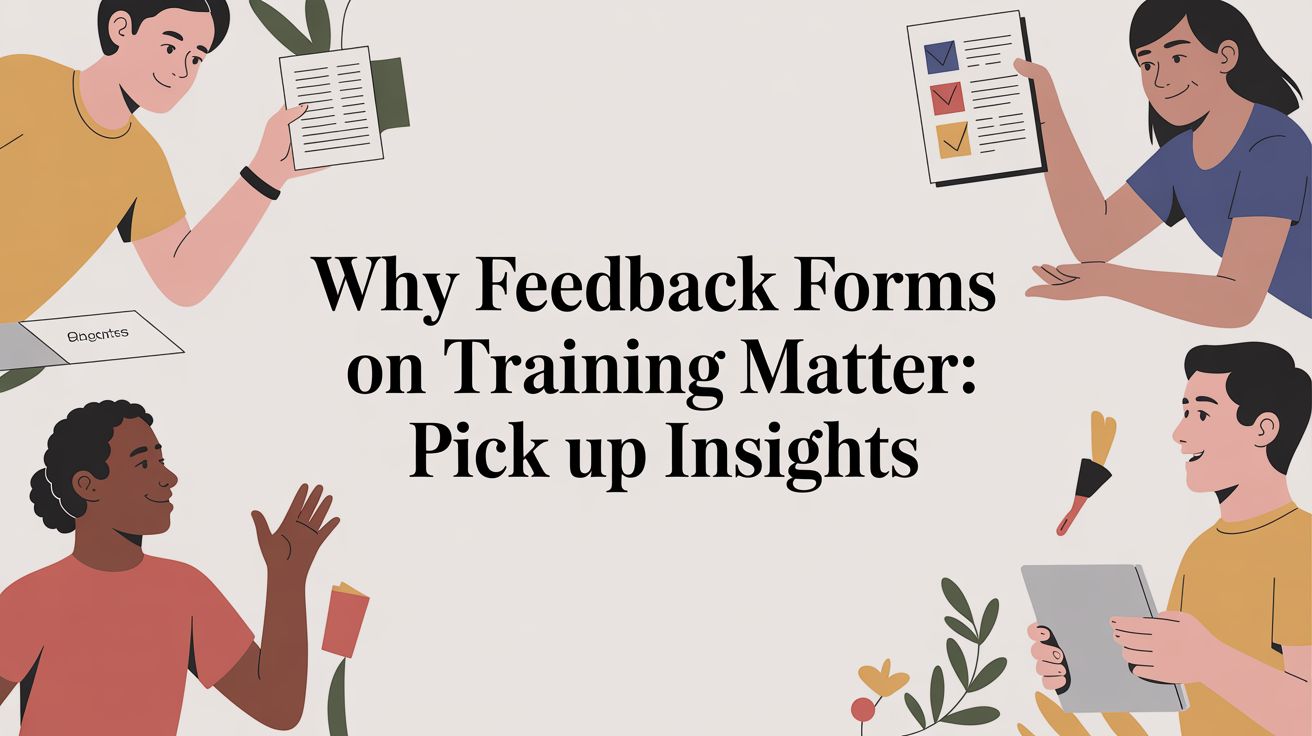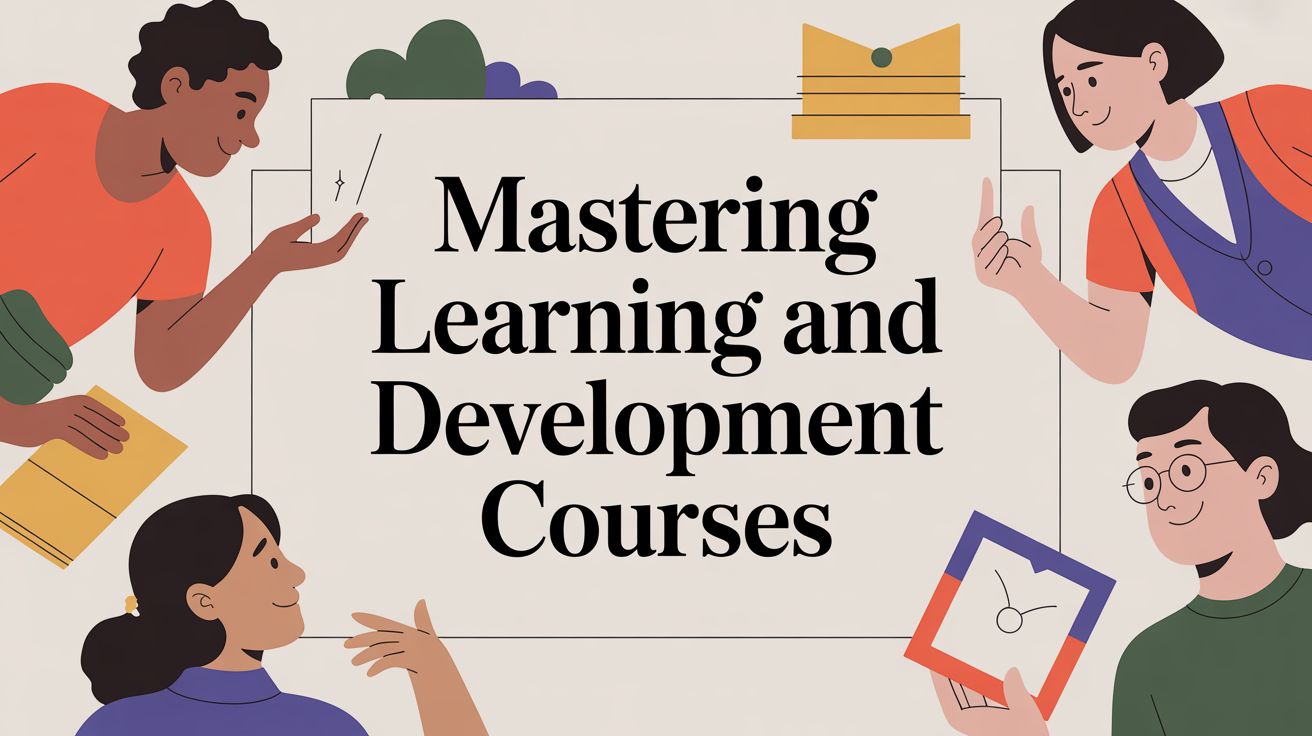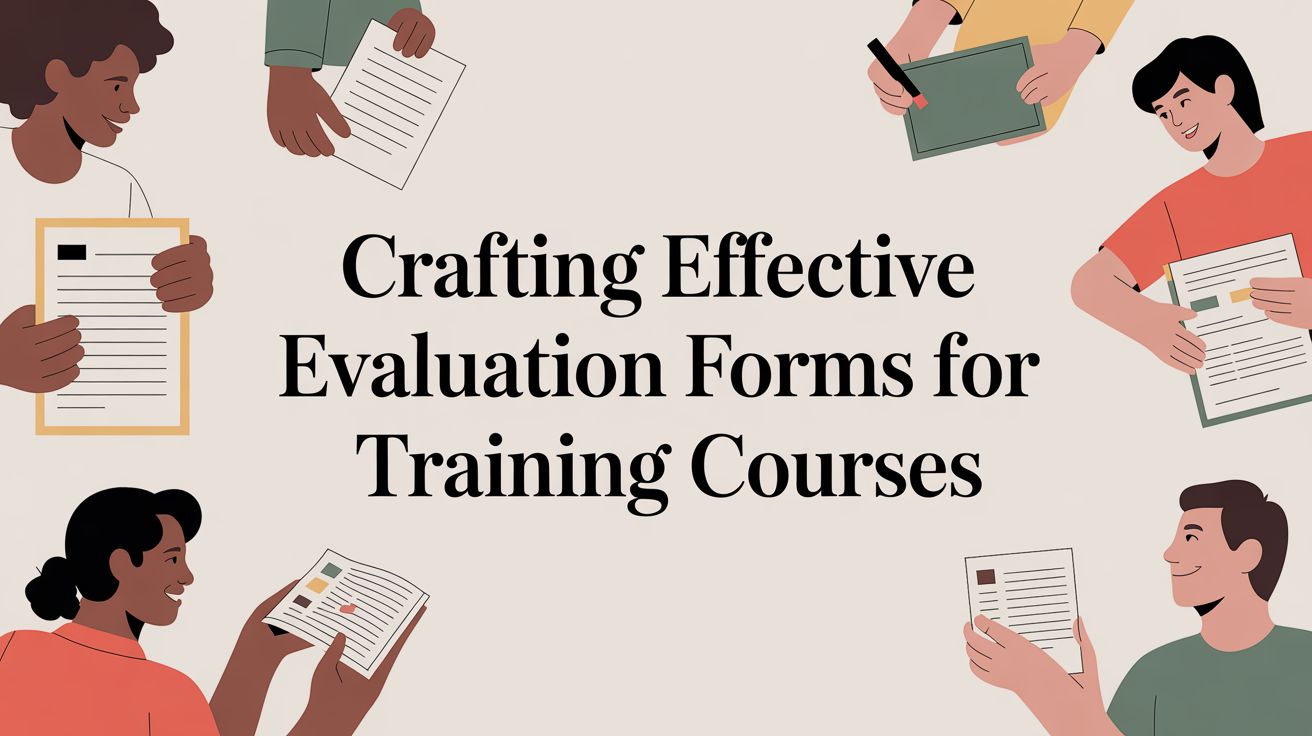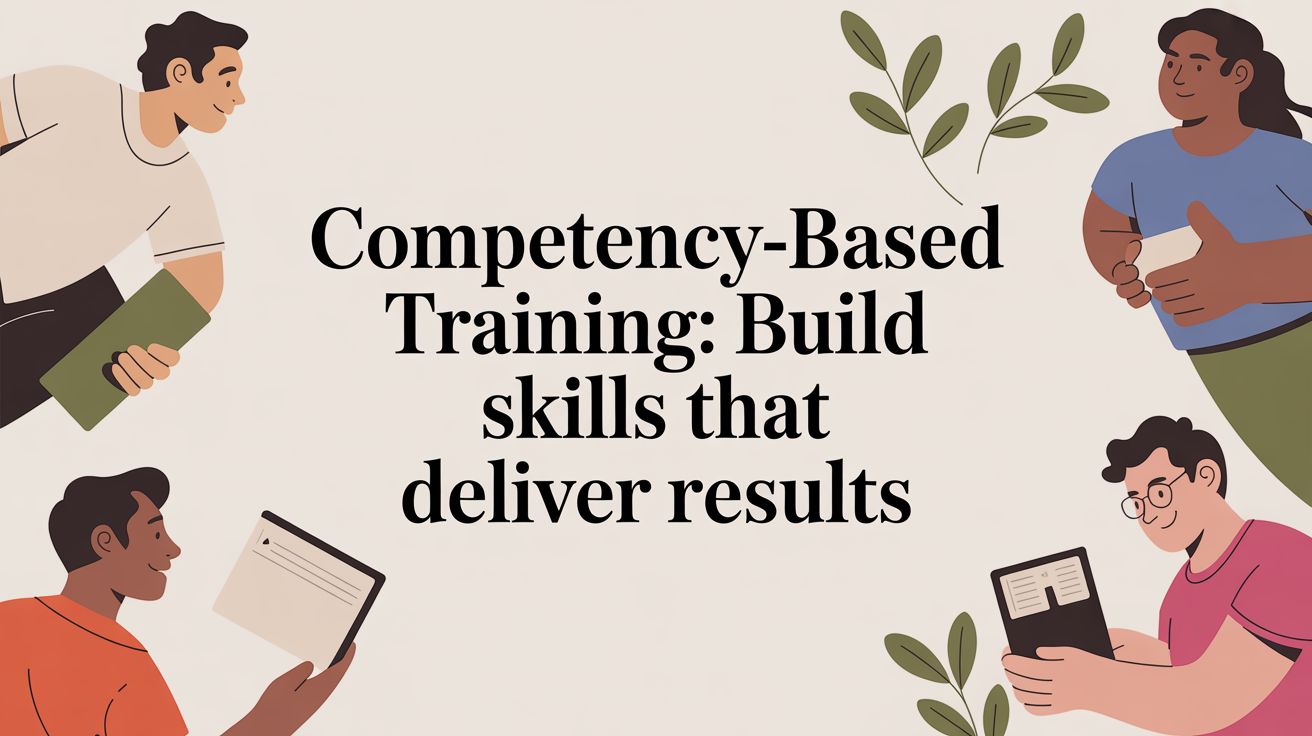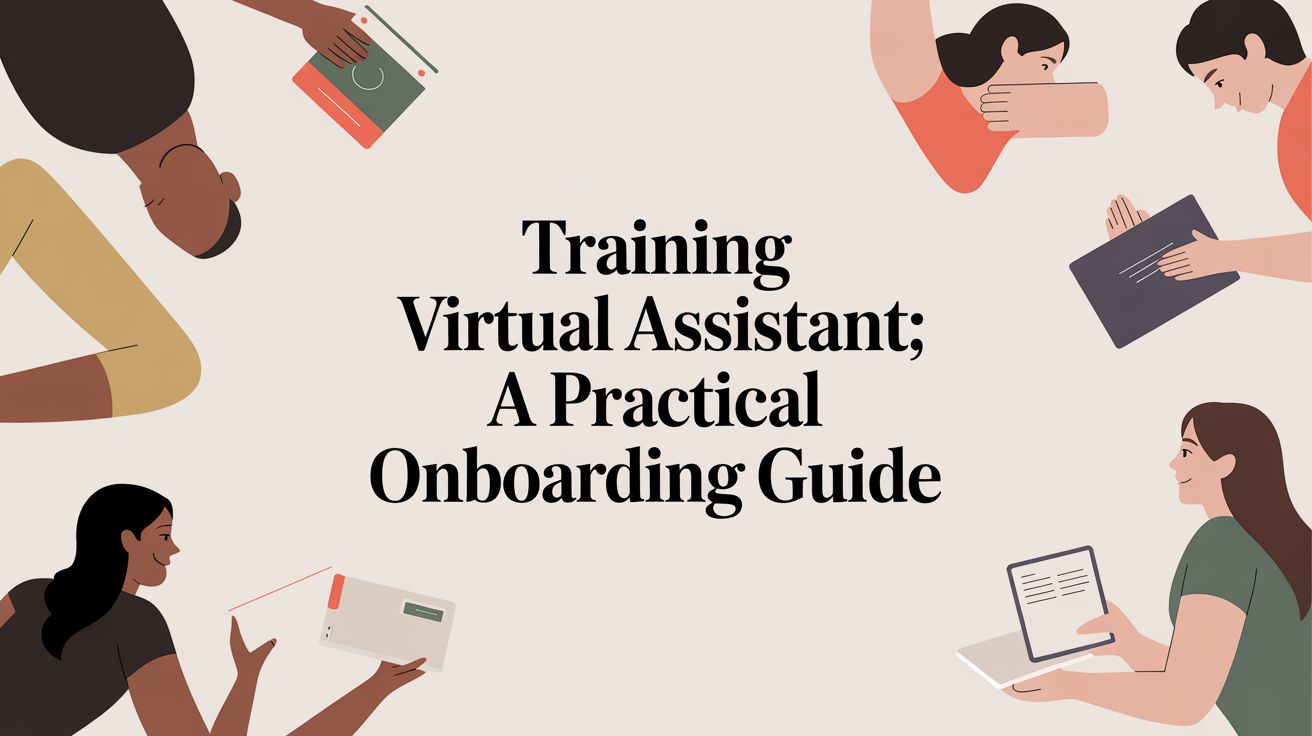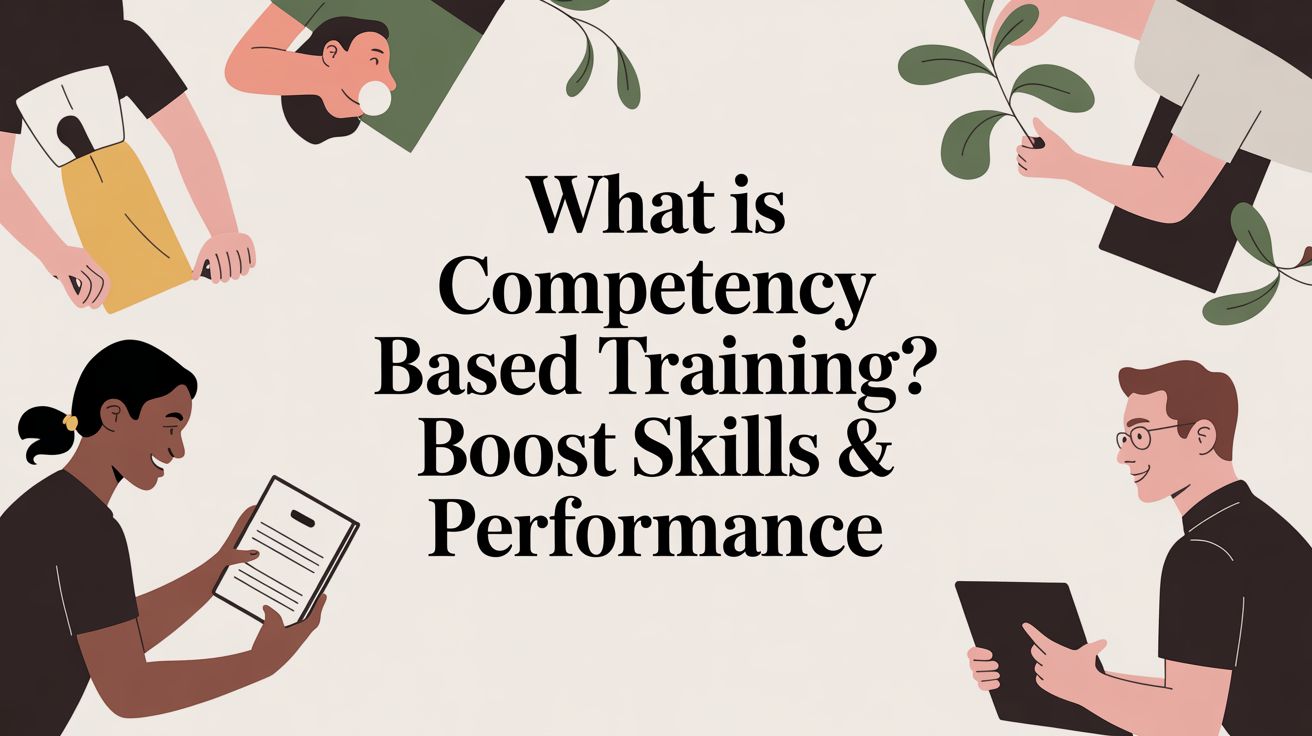10 Must-Have Class Evaluation Questions for 2025

Moving beyond generic feedback is crucial for impactful instructor-led training. The right class evaluation questions are the key to unlocking specific, actionable data that drives real improvement in course delivery, content, and learner engagement. Effective evaluations aren't just a formality; they are a strategic tool for enhancing the quality and effectiveness of your training programs. A simple "Did you enjoy the class?" yields little value, but asking "Which specific topic was least clear and why?" provides a direct path to refinement.
This article breaks down 10 critical categories of questions, providing targeted examples and tips to help you build a robust feedback system. We'll explore how to measure everything from instructor expertise to the inclusivity of the learning environment, ensuring you gather insights that truly matter for your face-to-face, hybrid, and live online sessions. For training managers and administrators, this structured approach transforms feedback from a passive measure into an active driver of quality. By asking better questions, you can pinpoint strengths to replicate and weaknesses to address, ensuring every training investment delivers maximum impact. You will learn how to craft surveys that provide clear, actionable data to elevate your entire training operation.
1. Instructor Knowledge and Subject Matter Expertise
Assessing an instructor's subject matter expertise is a foundational component of any effective class evaluation. These questions aim to measure how well the instructor understands the course material, stays current with industry developments, and communicates complex ideas with clarity and confidence. The credibility of the entire training program hinges on the perceived competence of the person leading it.
When students trust that their instructor is a genuine expert, they are more engaged and more likely to achieve their learning objectives. This is why leading institutions like the University of Washington and MIT prioritize instructor knowledge in their evaluation frameworks. A high rating in this area is a strong indicator of a successful learning experience.
Why This Question Matters
This category of class evaluation questions is essential because it directly correlates to learning outcomes. An instructor with deep expertise can answer unexpected questions, provide relevant, real-world examples, and adapt explanations to suit different learning styles. This adaptability builds student confidence and ensures the content is not just recited, but truly understood.
Actionable Tips for Implementation
To get the most out of these questions, focus on specifics and actionable feedback:
- Use Behavioral Descriptors: Instead of asking, "Was the instructor knowledgeable?" ask, "Did the instructor effectively answer complex questions and provide relevant, up-to-date examples?"
- Assess Content Currency: Include a sub-question like, "How current and relevant were the case studies, data, and examples used in the class?"
- Gauge Confidence: A simple rating scale can be powerful: "On a scale of 1-5, how confident were you in the instructor's expertise on the subject matter?"
Pro Tip: When managing multiple instructors for the same course, comparing expertise scores can reveal important training needs. A training management system like Coursebricks can help you track and compare this performance data efficiently, ensuring consistent quality across all sessions.
2. Course Organization and Structure
A well-organized course provides a clear roadmap for learners, guiding them from one concept to the next in a logical and understandable sequence. This category of class evaluation questions assesses the course’s overall design, from the clarity of learning objectives and syllabus to the logical flow of topics and accessibility of materials. The structure is the backbone of the learning experience, directly impacting a student's ability to follow along and retain information.
A coherent structure prevents confusion and helps students build knowledge progressively. Top institutions like Stanford University and the California State University system emphasize clear organization in their evaluation metrics because it is a strong predictor of student success. Even in self-paced environments, a logical framework is paramount; effective asynchronous learning platforms rely on intuitive design to keep learners engaged and on track.
Why This Question Matters
These questions are crucial because even the most knowledgeable instructor can fail to deliver an effective class if the content is disorganized. A logical structure ensures that foundational concepts are established before more complex ones are introduced, creating a seamless learning journey. It allows students to anticipate what’s next, connect new information to what they’ve already learned, and ultimately feel more in control of their own progress.
Actionable Tips for Implementation
To gather meaningful feedback on course structure, focus on the student's journey:
- Assess Syllabus Clarity: Ask directly, "How clear and helpful was the course syllabus in outlining expectations, topics, and assignments?"
- Evaluate Logical Flow: Include a question like, "Did the order of topics make sense and help you build your understanding of the subject progressively?"
- Check for Alignment: Measure consistency with a question such as, "On a scale of 1-5, how well did the daily activities and materials align with the stated learning objectives?"
Pro Tip: When analyzing feedback on course organization, look for patterns. If multiple students mention a confusing module or an illogical transition between topics, it’s a clear signal to revisit and refine that part of the curriculum before the next session.
3. Clarity of Instruction and Explanations
Beyond knowing the subject, an instructor's primary role is to make complex information understandable. This category of class evaluation questions assesses how effectively instructors present material, use clear language, provide helpful examples, and adapt their explanations to ensure student comprehension. It measures the fundamental teaching skill of making content accessible to a diverse group of learners.
An instructor can be a world-renowned expert, but if they cannot explain concepts clearly, learning will not occur. This is why institutions like Princeton University make instructional clarity a primary metric in their teaching evaluations. The ability to break down difficult topics is a hallmark of an effective educator.
Why This Question Matters
Clarity is the bridge between an instructor's knowledge and a student's understanding. Without it, even the most valuable content remains out of reach. These questions help identify instructors who can connect with learners, spot confusion, and reframe explanations to ensure the core message is received. High scores in this area directly correlate with higher knowledge retention and student success, making it a critical metric for any training program.
Actionable Tips for Implementation
To measure clarity effectively, move beyond generic inquiries and focus on specific instructional behaviors:
- Use Behavioral Anchors: Ask students to rate statements like, "The instructor explained complex topics using clear and easy-to-understand language."
- Assess Use of Examples: Include a question such as, "Did the instructor use relevant examples, analogies, or demonstrations to clarify difficult concepts?"
- Include Open-Ended Questions: Prompt for specific feedback with, "Please provide an example of a topic that was explained particularly well or one that you found confusing."
Pro Tip: Correlate clarity ratings with student performance data. A training management system can help you overlay feedback with assessment scores, revealing which instructional techniques are most effective for improving comprehension and achieving learning objectives. This data-driven approach helps refine your overall training delivery strategy.
4. Engagement and Enthusiasm
An instructor's passion for a subject can be infectious, transforming a standard lesson into a memorable and impactful learning experience. This set of class evaluation questions measures the instructor's ability to capture and maintain student interest, use dynamic teaching methods, and create an engaging atmosphere. It evaluates whether the instructor makes the subject matter compelling and keeps students motivated.
Highly engaging instructors don't just present information; they inspire curiosity and participation. Research from institutions like Yale highlights engagement metrics as crucial predictors of student success and content retention. When learners are actively involved rather than passively listening, the educational outcomes improve dramatically, reinforcing the importance of these questions in any comprehensive evaluation.
Why This Question Matters
This category is vital because enthusiasm directly impacts student motivation and persistence. A disengaged instructor can make even the most fascinating topic feel dull, leading to poor attendance and reduced participation. Conversely, an enthusiastic instructor fosters a positive and energetic learning environment where students feel encouraged to explore concepts, ask questions, and connect with the material on a deeper level.
Actionable Tips for Implementation
To effectively measure engagement, move beyond simple "yes/no" questions and seek detailed, behavioral feedback:
- Distinguish Engagement from Entertainment: Ask, "Did the instructor's teaching style facilitate learning and participation, or was it merely entertaining?"
- Measure Instructional Methods and Participation: Include questions like, "To what extent did the instructor use interactive methods (e.g., discussions, group work, polls) to engage the class?" You can explore more strategies for going beyond the lecture with interactive training.
- Assess Relevance: Frame a question to gauge real-world connection: "How well did the instructor connect the course content to your professional goals or real-world applications?"
Pro Tip: Compare engagement ratings with attendance and participation data within your training management system. A strong correlation can validate the effectiveness of an instructor's teaching style, while a discrepancy may signal that the methods used aren't resonating with your audience.
5. Respect and Inclusivity
Evaluating the classroom climate for respect and inclusivity is crucial for creating an effective and equitable learning experience. These questions assess whether the instructor fosters an environment where all students feel valued, respected, and supported, regardless of their background or perspective. The goal is to measure the instructor's commitment to creating a safe space for open dialogue and diverse viewpoints.
When learners feel psychologically safe, they are more likely to participate, ask questions, and engage deeply with the material. Leading institutions like the University of Michigan and UC Berkeley now emphasize inclusive teaching in their evaluation frameworks. A high score in this category indicates that the instructor is not just teaching a subject, but cultivating a community of learners.
Why This Question Matters
This category of class evaluation questions is essential because an inclusive environment is directly linked to student engagement and success. Instructors who demonstrate respect and actively include diverse perspectives help reduce learning barriers and improve outcomes for all participants. This focus ensures that the educational experience is equitable and that no student feels marginalized, which is fundamental to modern pedagogy.
Actionable Tips for Implementation
To gather meaningful feedback on inclusivity, focus on specific behaviors and environmental factors:
- Ask About Valuing Perspectives: Frame questions like, "Did the instructor encourage and respect diverse viewpoints during discussions?" instead of a generic "Was the instructor respectful?"
- Assess Accommodation: Include a question about learning needs, such as, "How well did the instructor accommodate different learning styles and needs?"
- Ensure Anonymity: Use a secure and anonymous feedback mechanism, especially for sensitive topics, to encourage honest responses from all students.
Pro Tip: Disaggregating feedback data by student demographics can reveal hidden equity gaps. A training management system like Coursebricks with advanced reporting can help you analyze this data to identify if specific groups feel less included, allowing for targeted instructor development.
6. Assessment Fairness and Feedback Quality
Evaluations are only as good as the assessments they measure. This category of class evaluation questions investigates whether grading is perceived as fair and consistent, and if feedback is constructive and timely. It assesses the alignment between assessment methods and learning objectives, ensuring that tests and assignments accurately measure comprehension and skill acquisition, rather than just memorization.
When learners understand the grading criteria and receive meaningful feedback, they are better equipped to improve. This focus on transparent and supportive assessment is why institutions like the University of Minnesota utilize clear, rubric-based evaluation systems. Fair assessment practices build trust and motivate learners to engage more deeply with the material.
Why This Question Matters
This line of questioning is crucial because it directly impacts student motivation and development. Unfair or unclear grading can demotivate learners, while a lack of constructive feedback leaves them without a path for improvement. By asking these questions, you gather data on whether your assessment strategy is supporting or hindering the learning process, which is a cornerstone of effective course design.
Actionable Tips for Implementation
To gather precise feedback on assessments and grading, focus on separating distinct concepts:
- Separate Fairness and Feedback: Ask distinct questions about grading fairness ("Were the grading criteria applied consistently?") and feedback quality ("Was the feedback you received constructive and specific?").
- Measure Timeliness: Include a specific question about the speed of feedback, such as, "Did you receive feedback on assignments within the timeframe stated in the syllabus?"
- Request Specifics: In an open-ended section, ask students to provide examples of feedback they found particularly helpful or unhelpful to identify best practices.
Pro Tip: Cross-reference student perceptions with actual grade distributions to identify potential discrepancies. If a course has a high failure rate and low fairness scores, it signals a need to review the assessment design. Designing effective evaluation forms for training courses is key to capturing this nuanced data.
7. Course Difficulty and Workload Appropriateness
Evaluating the course's difficulty and workload is crucial for ensuring a balanced and effective learning experience. These class evaluation questions measure whether the course challenges students appropriately without overwhelming them. The goal is to gauge if the workload is manageable and justified by the learning objectives, and if the pacing allows for genuine comprehension and mastery.
A well-calibrated course stretches learners to develop new skills but remains achievable, boosting both confidence and competence. Top institutions like Stanford University actively monitor workload to ensure it aligns with credit hours, while online education platforms often use difficulty ratings to help learners select appropriate courses. This balance is key to preventing burnout and maintaining high engagement.
Why This Question Matters
This category is essential for curriculum design and resource allocation. If a course is consistently rated as too difficult or having an excessive workload, it can lead to high dropout rates and negative feedback. Conversely, a course that is too easy may fail to deliver value. This feedback provides the data needed to adjust pacing, refine assignments, and ensure expectations are realistic and clearly communicated from the start.
Actionable Tips for Implementation
To gather precise feedback on difficulty and workload, focus on clear, specific questions:
- Distinguish Difficulty from Workload: Use separate items to ask about conceptual difficulty ("How challenging did you find the course concepts?") and time commitment ("How many hours per week did you spend on this course outside of class time?").
- Use a Reference Point: Frame workload questions in the context of the course's stated credit hours or expected duration to get more accurate responses.
- Break Down the Workload: Ask students to rate the time commitment of specific components, such as pre-reading, in-class activities, and final projects, to pinpoint what is most time-consuming.
Pro Tip: Track workload data over multiple sessions for the same course. A training management system like Coursebricks allows you to analyze these trends, helping you identify if a recent curriculum change has unintentionally increased the workload or if a particular instructor's session requires more student effort.
8. Availability and Communication
Effective learning extends beyond the classroom, making an instructor's availability and communication channels a critical factor in student success. This category of class evaluation questions assesses how accessible and responsive the instructor is to student needs. It evaluates the clarity of communication methods, the usefulness of office hours, and the promptness of responses, which collectively measure the instructor's commitment to providing robust student support.
When students know how and when they can receive help, their confidence and engagement increase significantly. This is why leading advising bodies like NACADA emphasize accessibility and responsiveness as core components of effective student support. A high rating in this area shows that an instructor has created a supportive and accessible learning environment.
Why This Question Matters
This category of questions is essential because it directly impacts a student's ability to overcome learning obstacles. An instructor who is perceived as unapproachable or slow to respond can create a significant barrier to progress, leading to frustration and disengagement. Clear, consistent, and timely communication ensures that students feel supported and valued, which is crucial for maintaining motivation and achieving learning outcomes.
Actionable Tips for Implementation
To gather meaningful feedback on availability, focus on both the stated policies and the student experience:
- Differentiate Communication Channels: Ask separate questions about synchronous (e.g., office hours) and asynchronous (e.g., email, forum) communication to get a clearer picture.
- Assess Response Time: Use a specific question like, "Did the instructor respond to questions and inquiries within the timeframe stated in the syllabus?"
- Evaluate Clarity: Include an item such as, "On a scale of 1-5, how clear were the instructions for contacting the instructor for help?"
Pro Tip: Compare student survey responses with the instructor's stated availability and communication policies. A training management system like Coursebricks can help you centralize instructor profiles and their stated office hours, making it easier to identify discrepancies and ensure policies are being followed consistently.
9. Learning Outcomes and Skill Development
This category of class evaluation questions moves beyond satisfaction to measure the ultimate purpose of a course: did participants actually learn what they were supposed to learn? These questions evaluate whether students achieved the stated learning objectives, developed relevant skills, and can apply their new knowledge in practical contexts. This is the core measure of training effectiveness.
Focusing on outcomes aligns evaluations with the strategic goals of the training program. Accreditation bodies like ABET for engineering and the AAC&U with its VALUE rubrics heavily emphasize outcomes assessment because it provides tangible proof of learning. A course can be engaging and well-delivered, but if participants walk away without new skills, it has failed its primary objective.
Why This Question Matters
Measuring learning outcomes provides the most direct evidence of a course’s impact and return on investment. It helps distinguish between a "feel-good" training experience and one that genuinely builds capability. When assessing how well a course contributes to skill development, understanding how students engage in effective study strategies can provide additional context for their success. This data is critical for program improvement, demonstrating value to stakeholders, and ensuring the curriculum meets its intended goals.
Actionable Tips for Implementation
To effectively measure skill development, your questions must be specific and application-focused:
- Align to Objectives: For each stated learning objective, create a corresponding question. For example, "To what extent can you now apply the XYZ framework to solve a real-world problem?"
- Use Self-Assessment Scenarios: Ask participants to rate their confidence or ability to perform a specific task before and after the course to measure perceived growth.
- Request Specific Examples: Include an open-ended question like, "Please provide one example of how you plan to use what you learned in your work."
Pro Tip: Transitioning to a model that explicitly tracks skill acquisition can transform your training programs. You can dive deeper into this approach by exploring the principles of competency-based training to build a more robust and evidence-based evaluation framework.
10. Course Materials and Resources Quality
The effectiveness of a course is significantly influenced by the quality, relevance, and accessibility of its supporting materials. These class evaluation questions assess everything from textbooks and readings to online resources and supplementary handouts, gauging whether they genuinely support the learning objectives. High-quality materials enhance understanding, while poor or outdated resources can actively hinder it.
Evaluating resources is a practice championed by institutions focused on student success. Initiatives like MIT OpenCourseWare prioritize resource quality, while organizations like OpenStax advocate for the evaluation and adoption of open educational resources (OER) to improve both accessibility and value. Feedback in this area provides a clear roadmap for refining the tools that students rely on to learn.
Why This Question Matters
This category is crucial because course materials are the tangible bridge between instructor-led teaching and independent student learning. Well-chosen resources reinforce concepts, provide diverse perspectives, and allow learners to explore topics at their own pace. Conversely, materials that are irrelevant, hard to access, or overly expensive can create significant barriers to success and generate negative perceptions of the entire program.
Actionable Tips for Implementation
To gather meaningful feedback on course materials, frame your questions to elicit specific, useful responses:
- Separate Quality and Value: Ask distinct questions about the relevance of the material to the learning objectives and the cost-effectiveness or perceived value.
- Assess Accessibility: Inquire about the ease of accessing materials in different formats (e.g., "Were digital resources easy to navigate and compatible with your devices?").
- Request Specifics: Instead of a generic rating, ask, "Which specific resource was most helpful, and which was least helpful? Why?" This provides direct insights for future course design.
Pro Tip: Use your training management system to track feedback on course materials over time. By correlating satisfaction scores with specific resources, you can identify which materials consistently perform well and which may need to be replaced, ensuring your resource library remains effective and valuable.
10-Point Class Evaluation Comparison
| Item | Implementation Complexity | Resource Requirements | Expected Outcomes | Ideal Use Cases | Key Advantages |
|---|---|---|---|---|---|
| Instructor Knowledge and Subject Matter Expertise | Medium — requires evaluation criteria and peer input | Low–Medium — student surveys, peer review, CV review | Improved content accuracy and student learning gains | Advanced/specialized courses; accreditation reviews | Strong link to learning; measurable by students and peers |
| Course Organization and Structure | Low–Medium — syllabus and sequence design | Low — time for planning and materials organization | Clear progression and reduced student confusion | New courses, online modules, large cohorts | Predictable learning path; improves comprehension |
| Clarity of Instruction and Explanations | Low — instructional practice and feedback loops | Low — training, examples, rubrics | Better comprehension and performance | Introductory courses; diverse learner groups | Highly actionable; broad impact on outcomes |
| Engagement and Enthusiasm | Medium — redesign activities and delivery methods | Medium — interactive tools and preparation time | Higher motivation, participation and retention | Large lectures, active-learning environments | Boosts motivation and long-term retention |
| Respect and Inclusivity | Medium–High — policy, training and cultural change | Medium — training, inclusive materials, support services | Increased belonging and equity; improved retention | Diverse classrooms; equity initiatives | Supports wellbeing; essential for inclusive education |
| Assessment Fairness and Feedback Quality | High — rubric design, calibration and oversight | Medium–High — rubrics, LMS features, instructor time | Fairer grading, clearer improvement pathways | Skill-based programs; summative assessments | Transparency in grading; drives learning improvement |
| Course Difficulty and Workload Appropriateness | Medium — workload calibration and alignment | Low–Medium — analysis of credit hours and assignments | Reduced burnout; better pacing and achievement | Intensive programs; curriculum planning | Balances rigor and student wellbeing |
| Availability and Communication | Low — set policies and communication norms | Low — office hours, platforms, response tracking | Faster support and increased student confidence | Online/hybrid courses; students needing support | Directly improves support; easy to implement |
| Learning Outcomes and Skill Development | High — requires alignment, assessments and tracking | High — pre/post tests, performance data, longitudinal follow-up | Demonstrable skill gains and program effectiveness | Accreditation, competency-based education, program assessment | Core measure of course value; links to institutional goals |
| Course Materials and Resources Quality | Low–Medium — evaluate and update resources | Medium — licensing, OER adoption, tech support | Better access, relevance and cost-effectiveness | Cost-sensitive programs; online courses | Impacts access and costs; often straightforward to improve |
Putting Feedback into Action: Streamlining Your Evaluation Process
Crafting the right class evaluation questions is the essential first step toward meaningful improvement. As we've explored, focusing on specific areas like instructor clarity, course structure, resource quality, and skill development provides a comprehensive picture of the learner experience. Moving beyond generic "Did you like the class?" queries to more targeted, actionable questions is the foundation of a data-driven training program.
However, even the most thoughtfully designed questions will fall short if the process of collecting and analyzing feedback is cumbersome and inefficient. The true power of this data is unlocked not just by asking the right questions, but by creating a seamless system to act on the answers.
From Data Collection to Strategic Improvement
The ultimate goal is to transform feedback from a simple administrative task into a strategic asset. The journey from a raw survey response to an improved training session involves several key stages:
- Systematic Collection: Ensuring every participant has an easy, consistent way to provide feedback after each session.
- Centralized Analysis: Aggregating data to spot trends, identify high-performing instructors, or pinpoint recurring issues with course materials.
- Actionable Reporting: Translating raw scores and comments into clear reports that guide decisions for instructors, content developers, and training managers.
- Closing the Loop: Demonstrating to learners and instructors that their feedback is valued and leads to tangible changes.
This cycle of continuous improvement is difficult to maintain with manual processes. Juggling spreadsheets, email reminders, and scattered documents creates administrative bottlenecks, delays insights, and increases the risk of valuable feedback getting lost.
Pro-Tip: Don't let your evaluation process become an administrative burden. The goal is to spend more time analyzing insights and supporting instructors, not chasing down survey responses or manually compiling data in spreadsheets.
The Role of a Training Management System
This is where a dedicated training management system (TMS) like Coursebricks becomes invaluable, particularly for organizations managing instructor-led training. Unlike a Learning Management System (LMS) designed for asynchronous e-learning, a TMS is built to handle the unique logistics of live, hybrid, and face-to-face training events.
By integrating your evaluation process directly into your training operations, you can automate the entire workflow. A TMS can automatically send customized evaluation forms to attendees immediately after a class concludes. Responses are collected and organized in a central dashboard, allowing you to generate reports and analyze trends with just a few clicks. This automation frees your team from tedious administrative work, enabling them to focus on the high-impact activities that truly drive quality.
By leveraging the right class evaluation questions within a streamlined system, you create a powerful engine for growth. You empower instructors with the specific feedback they need to excel, provide stakeholders with clear evidence of training effectiveness, and assure learners that their voice is integral to shaping a better educational experience. This strategic approach turns feedback from a retrospective chore into a forward-looking catalyst for excellence.
Ready to explore Coursebricks?
Manage training programs, automate emails, and generate detailed reports — all in one place.



